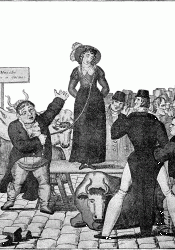Divorce and Matrimonial Causes Act of 1857
The novel Jane Eyre written by Charlotte Bronte paints a clear picture of the injustices of marriage laws in the 1800s when the novel takes place. A marriage in England was “legally an indissoluble union” (Holmes). Men could not divorce a woman and a woman could not divorce a man. This however changed to only allow men to request divorce, most likely on the terms of a cheating wife. A bastard son was the last thing a rich man wanted to be known for in society. A name, fortune, or social status could easily be stripped of its meaning if it was found that a man had a bastard son. If a woman, however, was being cheated on by her husband, she could not ask for a divorce. There was a huge double standard. This was the case until the Divorce and Matrimonial Causes Act of 1857 was introduced. “This allowed women to end the marriage only if her husband’s adultery had been compounded by another matrimonial offense” (The Origins of Victorian Divorce Law). It was not until the ‘Matrimonial Causes Act of 1923 that allowed both men and women to divorce their partner for adultery’ (The Origins of Victorian Divorce Law). There were no longer double standards, but adultery was the only requirement. This plays a role in the novel by showing why Mr. Rochester cannot divorce Bertha and must stay with her, even though she is clinically insane. This was a huge part of the novel due to Mr. Rochester and Jane Eyre’s marriage ceremony being the turning point of the entire novel. If Mr. Rochester would have divorced Bertha, he would have married Jane Eyre and she would have never found her cousins who she now has a sisterly and brotherly connection with. She also might not have inherited her fortune, which brings Jane from poverty. Including this real-world problem of divorce not being readily available in the 1800s allows the reader to understand the severity and seriousness of marriage. St. John asking Jane to marry him, shows the reader that once Jane marries him, she would be with him for the rest of her life. Mr. Rochester and Jane Eyre’s situation also demonstrates the severity of the divorce laws as he must keep his wife locked away with special care due to her being insane. He, however, is stuck with her. This shows the reader that the subject of marriage is not taken lightly.
Works Cited
Holmes, Ann Sumner. “The Double Standard in the English Divorce Laws, 1857–1923: Law & Social Inquiry.” Cambridge Core, Cambridge University Press, 27 Dec. 2018, https://www.cambridge.org/core/journals/law-and-social-inquiry/article/a...
Kristen Koster. “Regency Divorce and Annulments: A Primer by Kristen Koster.” Kristen Koster, 29 May 2019, https://www.kristenkoster.com/a-regency-divorce-primer/.
“The Origins of Victorian Divorce Law.” The Origins of Victorian Divorce Law, https://www.victorianweb.org/gender/layton2.html.

